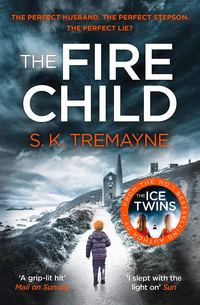
The Fire Child: The 2017 gripping psychological thriller from the bestselling author of The Ice Twins
A fine but angled autumn sun makes a rich amber patch of light on the polished floorboards. These boards creak as I step forward, and open the door.
I’ve only been in this spacious, cedar-scented room three or four times before, and always in David’s presence. Now I gaze about, in faint but definite awe. There are several ancient portraits on the wood-panelled walls. Clumsy, vernacular portraits of patriarchal Kerthens: portraits of rich men who could only commission very provincial painters.
I know the biggest and darkest of these portraits shows Jago Kerthen, the man who sank the Jerusalem Shaft in the 1720s. He had a reputation, David says, for severity, if not brutality. Damning men to death down risky pits, urging them on through day and night, his troops of willing Cornishmen with their tallow candles glued on to their little hats. Jago Kerthen’s pale blue eyes glint with avarice in the gold-framed portrait: however clumsy the artist, he caught that look well enough. Yet it was Jago Kerthen’s appalling greed that turned the Kerthen thousands into millions in the early eighteenth century.
David has positioned the portrait so that it stares out of the tall sash window, down the last of Carnhallow Valley to the just-visible blackness of Morvellan Mine. And then onwards, to the shimmering wastes of the sea. The greedy and violent Jago Kerthen is staring at the very same mine he sank into the granite.
I’ve no doubt this positioning is deliberate.
The rest of the room is also very David. A couple of fine abstract paintings, possibly even a Mondrian. The floor is softened by some of those Azeri rugs David likes, apparently superior to Turkish or Persian rugs. As I look down, I can hear him airily explaining, as is his wont, ‘Oh, them, yes, the rugs, I bought them in Baku.’
Dominating the room is a large desk, solidly built, and clearly old. I walk closer, swallowing my sense of impropriety, the sense that I shouldn’t be here. Prying.
A brand new Apple laptop, firmly closed, sits right next to military memorabilia, from all the Kerthens who went to England’s wars: there are medals with faded sashes, from the Crimean and Peninsular wars, and beside them a rusty old revolver with mud still visible in its metalwork – probably, I’m guessing, from the First World War. Then a long, gleaming sword with a gilded hilt. Looking close, I see that it is engraved Harry St John Tresillian Kerthen, Paardeburg, 1900.
On the other side of this big desk there are three photos. Paired together is a tilted photo of me and David – and one of Nina and David. Both photos taken at our respective weddings. I try not to compare them: the swaying beauty of her wedding dress compared to my humble summer frock, the sense of grandeur in Nina’s glamorous nuptials compared to my modest London party. I resist the urge to slap the photo of Nina face down on the desktop.
The third silver-framed photo is of Jamie, aged four or five, laughing unselfconsciously in the sunlit kitchen here at Carnhallow. It is a poignant, lovely image: Jamie is looking at his beloved mother, almost off-camera, who has apparently made him laugh. He looks piercingly happy, in a way I have never witnessed. I have never seen this laughing, happy boy, the untroubled son before his mother’s death.
The sense of loss throbs, in this study, like a reopened wound at the heart of Carnhallow. And I feel like I am the shard in the flesh. Renewing the hurt.
And yet I am doing this for the best reason: helping Jamie. So I will carry on. Crossing the room, I examine the bookshelves. I know, from being here before, that one of these shelves is dedicated to Jamie: it holds everything from his school reports to his football rosettes. The last time I was in here with David I saw him take out Jamie’s medical records.
I run my hand along the shelf. A school photo. Some exercise books. Vaccination records. Blood type, A. Birth certificate, 3 March. Gold star for English, Year 2. I pause at an untitled folder, then pull it out, and open it up.
There’s not much in here. A few loose pages with some childish writing. Yet, as I read on, I am choked with unexpected emotion as I realize that I am holding Jamie’s letters to his dead mother.
Dear mummy
I am riting this because the therappist in the hospittal says it is good if I rite to you now you are dead. I miss you mummy. You were funny wen you put sand on yor nose in France when we went on holliday. Every day I think of you after you fel down
Since you
Lots of things hapend some of them were very sad and daddy went away a lot like and he says he misses you to. I have a new pencil case now mummy.
After you fel in the water granny tolld said sayed you were on a very long holiday and I askd somewere like France and she says Yes. But daddy sayed you are not comeing back and granny sed a ly and you were dead and not comeing back.
I have a lift the flap book
Конец ознакомительного фрагмента.
Текст предоставлен ООО «ЛитРес».
Прочитайте эту книгу целиком, купив полную легальную версию на ЛитРес.
Безопасно оплатить книгу можно банковской картой Visa, MasterCard, Maestro, со счета мобильного телефона, с платежного терминала, в салоне МТС или Связной, через PayPal, WebMoney, Яндекс.Деньги, QIWI Кошелек, бонусными картами или другим удобным Вам способом.
Вы ознакомились с фрагментом книги.
Для бесплатного чтения открыта только часть текста.
Приобретайте полный текст книги у нашего партнера:
Полная версия книги
